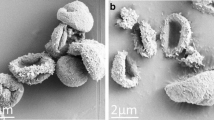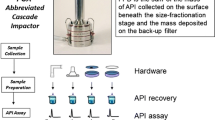Abstract
Purpose
To establish an in vivo-relevant Transwell dish-based dissolution test system for the “respirable” aerosols of inhaled corticosteroids (ICSs) using marketed inhaler products.
Methods
“Respirable” ≤ 5.8 or 6.5 μm aerosols of 7 ICSs from 11 inhaler products were collected onto the filter membranes under the modified assembly of the cascade impactor. Their dissolution in 10 ml of the simulated lung lining fluid (sLLF) was determined over time in the Transwell dish at 37°C and ~100% relative humidity in the presence of subsequent diffusive permeation across the Transwell’s supporting membrane.
Results
While three ICSs with high-to-intermediate solubility enabled the first-order “sink” and complete dissolution in 6 h, 4 ICSs with poor solubility including fluticasone propionate (FP) resulted in the pseudo-zero-order “non-sink”, slow and limited dissolution. The aerosol dissolution rate constants (kdiss) were derived, well-correlated with the solubility. For FP, but not for highly-soluble flunisolide (FN), dissolution was kinetically aerosol mass-dependent. However, for a given ICS, dissolution profiles were indistinguishable between the formulations and products upon comparable aerosol mass collection.
Conclusions
The in vivo-relevant Transwell dish-based “respirable” aerosol dissolution test system was developed, kinetically discriminative in accordance with the ICS solubility, but indistinguishable for a given ICS between the marketed products.








Similar content being viewed by others
Abbreviations
- ACI:
-
Andersen cascade impactor
- BD:
-
Budesonide
- BDP:
-
Beclomethasone dipropionate
- BE:
-
Bioequivalence
- CFC:
-
Chlorofluorocarbon
- CIC:
-
Ciclesonide
- DPI:
-
Dry powder inhaler
- DPPC:
-
Dipalmitoyl phosphatidylcholine
- FDA:
-
Food and Drug Administration
- FN:
-
Flunisolide
- FP:
-
Fluticasone propionate
- HFA:
-
Hydrofluoroalkane
- HPLC-UV:
-
High performance liquid chromatography method with ultraviolet detection
- ICS:
-
Inhaled corticosteroid
- IVIVC:
-
In vitro and in vivo correlation
- kdiss :
-
Rate constant for dissolution
- kobs :
-
Observed rate constant for dissolution and permeation
- kperm :
-
Rate constant for permeation
- LLF:
-
Lung lining fluid
- MDI:
-
Metered dose inhaler
- MF:
-
Mometasone furoate
- NC:
-
Nitrocellulose
- OIDP:
-
Orally inhaled drug product
- PC:
-
Polycarbonate
- PK:
-
Pharmacokinetics
- SD:
-
Standard deviation
- sLLF:
-
Simulated lung lining fluid
- TA:
-
Triamcinolone acetonide
- TPGS:
-
d-α-tocopheryl polyethylene glycol 1000 succinate
- USP:
-
United States Pharmacopeia
References
Adams WP, Ahrens RC, Chen ML, Christopher D, Chowdhury BA, Conner DP, et al. Demonstrating bioequivalence of locally acting orally inhaled drug products (OIPs): workshop summary report. J Aerosol Med Pulm Drug Deliv. 2010;23(1):1–29.
O'Connor D, Adams WP, Chen ML, Daley-Yates P, Davis J, Derendorf H, et al. Role of pharmacokinetics in establishing bioequivalence for orally inhaled drug products: workshop summary report. J Aerosol Med Pulm Drug Deliv. 2011;24(3):119–35.
Apiou-Sbirlea G, Newman S, Fleming J, Siekmeier R, Ehrmann S, Scheuch G, et al. Bioequivalence of inhaled drugs: fundamentals, challenges and perspectives. Ther Deliv. 2013;4(3):343–67.
Lu D, Lee SL, Lionberger RA, Choi S, Adams W, Caramenico HN, et al. International guideline for bioequivalence of locally acting orally inhaled drug products: similarities and differences. AAPS J. 2015;17(3):546–57.
Lionberger RA. New tools for generic orally inhaled drug products to maximize prospects of Food and Drug Administration approval. Respiratory Drug Delivery 2018 (edited by Dalby RN, Byron PR, Hindle M, Peart J, Traini D, Young PM, Farr SJ, Suman JD, Watts A) 2018;1:221–230.
Riley T, Christopher D, Arp J, Casaza A, Cooper A, Dey M, et al. Challenges with developing in vitro dissolution test for orally inhaled products (OIPs). AAPS PharmSciTech. 2012;13(3):978–89.
Sakagami M. Fluticasone pharmacokinetics: meta-analysis and models. Respiratory drug delivery 2014 (edited by Dalby RN, Byron PR, Peart J, Farr SJ, Suman JD, young PM, Traini D) 2014;1:143–154.
Department of Health and Human Services. Development of in vivo predictive dissolution method for orally inhaled drug products. Posted on April 2013 at https://grants.nih.gov/grants/guide/rfa-files/RFA-FD-13-014.html. Accessed 30 April 2019.
Forbes B, Bäckman P, Christopher D, Dolovich M, Li BV, Morgan B. In vitro testing for orally inhaled products: developments in science-based regulatory approaches. AAPS J. 2015;17(4):837–52.
Son YJ, McConville JT. Development of a standardized dissolution testing method for inhaled pharmaceutical formulations. Int J Pharm. 2009;382(1–2):15–22.
Arora D, Shah KA, Halquist MS, Sakagami M. In vitro aqueous fluid-capacity-limited dissolution testing for respirable aerosol drug particles generated from inhaler products. Pharm Res. 2010;27(5):786–95.
United States Pharmacopeial Convention, General Chapter <601> Inhalation and nasal drug products: aerosols, sprays, and powders – performance quality tests. 2017. USP40-NF35. Rockville, MD.
United States Pharmacopeial Convention, General Chapter <1092> The dissolution procedure: development and validation. 2017. USP40-NF35. Rockville, MD.
Mitchell JP, Nagel MW, Avvakoumova V, MacKay H, Ali R. The abbreviated impactor measurement (AIM) concept: part 1 – influence of particle bounce and re-entrainment – evaluation with a “dry” pressurized metered dose inhaler (pMDI)-based formulation. AAPS PharmSciTech. 2009;10(1):243–51.
Puig-Rigall J, Grillo I, Dreiss CA, Gonzalez-Gaitano G. Structural and spectroscopic characterization of TPGS micelles: disruptive role of cyclodextrins and kinetic pathways. Lungmuir. 2017;33(19):4737–47.
Leach CL, Davidson PJ, Boudreau RJ. Improved airway targeting with the CFC-free HFA-beclomethasone metered-dose inhaler compared with CFC-beclomethasone. Eur Respir J. 1998;12(6):1346–53.
Sakagami M, Arora-Lakhani D. understanding dissolution in the presence of competing cellular uptake and absorption in the airways. Respiratory drug delivery 2012 (edited by Dalby RN, Byron PR, Peart J, Suman JD, Farr SJ, Young PM) 2012;1:185–192.
Fröhlich E, Mercuri A, Wu S. Salar-Behzadi. Measurements of deposition, lung surface area and lung fluid for simulation of inhaled compounds. Front Pharmacol. 2016;7:181.
Krishnaswami S, Hochhaus G, Möllmann H, Barth J, Drendorf H. Interpretation of absorption rate data for inhaled fluticasone propionate obtained in compartmental pharmacokinetic modeling. Int J Clin Pharmacol Ther. 2005;43(3):117–22.
Gray VA, Hickey AJ, Balmer P, Davies NM, Dunbar C, Foster TS, et al. The inhalation ad hoc advisory panel for the USP performance tests of inhalation dosage forms. Pharmacopeial Forum. 2008;34(4):1068–74.
Author information
Authors and Affiliations
Corresponding author
Additional information
Publisher’s Note
Springer Nature remains neutral with regard to jurisdictional claims in published maps and institutional affiliations.
Electronic supplementary material
ESM 1
(DOCX 45 kb)
Rights and permissions
About this article
Cite this article
Sakagami, M., Li, H. & Venitz, J. In Vivo-Relevant Transwell Dish-Based Dissolution Testing for Orally Inhaled Corticosteroid Products. Pharm Res 36, 95 (2019). https://doi.org/10.1007/s11095-019-2635-2
Received:
Accepted:
Published:
DOI: https://doi.org/10.1007/s11095-019-2635-2




